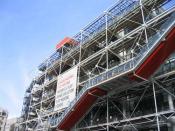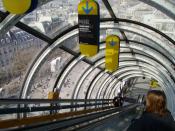Centre Georges Pompidou (1971-1977) is a building that has challenged the limits of the imagination of its designers as well as the properties of the materials it is made of. The centre has a high profile that goes beyond its gigantic scale. It was a project long anticipated by people of France and launched by their President. It was also engineered by Britain's top engineers, and has put its architects on the map. This has inevitably attracted endless heated debates on the building, be it political, cultural, technical or architectural. It is however an unmistakable fact that the Centre was the forerunner in structural technology of its time. This essay attempts to discuss above all the structural technology of the centre in relation to the style of architecture which it represents.
The background of Centre Pompidou can be tracked down to a few decades prior to its construction. Long before the Second World War, there had been proposals in Paris for an Art Centre on the right bank to provide a better artistic balance to the city.
Subsequently, the 1960s saw an evolution towards European unity in progress and the search for a capital of Europe. Paris found itself in competition with other major European cities to become the centre for banking, commercial and cultural in a time of general economic expansion. There were already plans for a new business centre in La Defense but Paris lacked a central institutionalised cultural apparatus. The project for an institutionalised cultural centre emerged as a logical necessity because it was nonetheless apparent that various government sponsored activities and initiatives in the cultural domain were too fragmented and dispersed.
In 1969 George Pompidou, a professor turned politician, was elected the President of France. As an amateur of modern art he lent a sympathetic ear...


